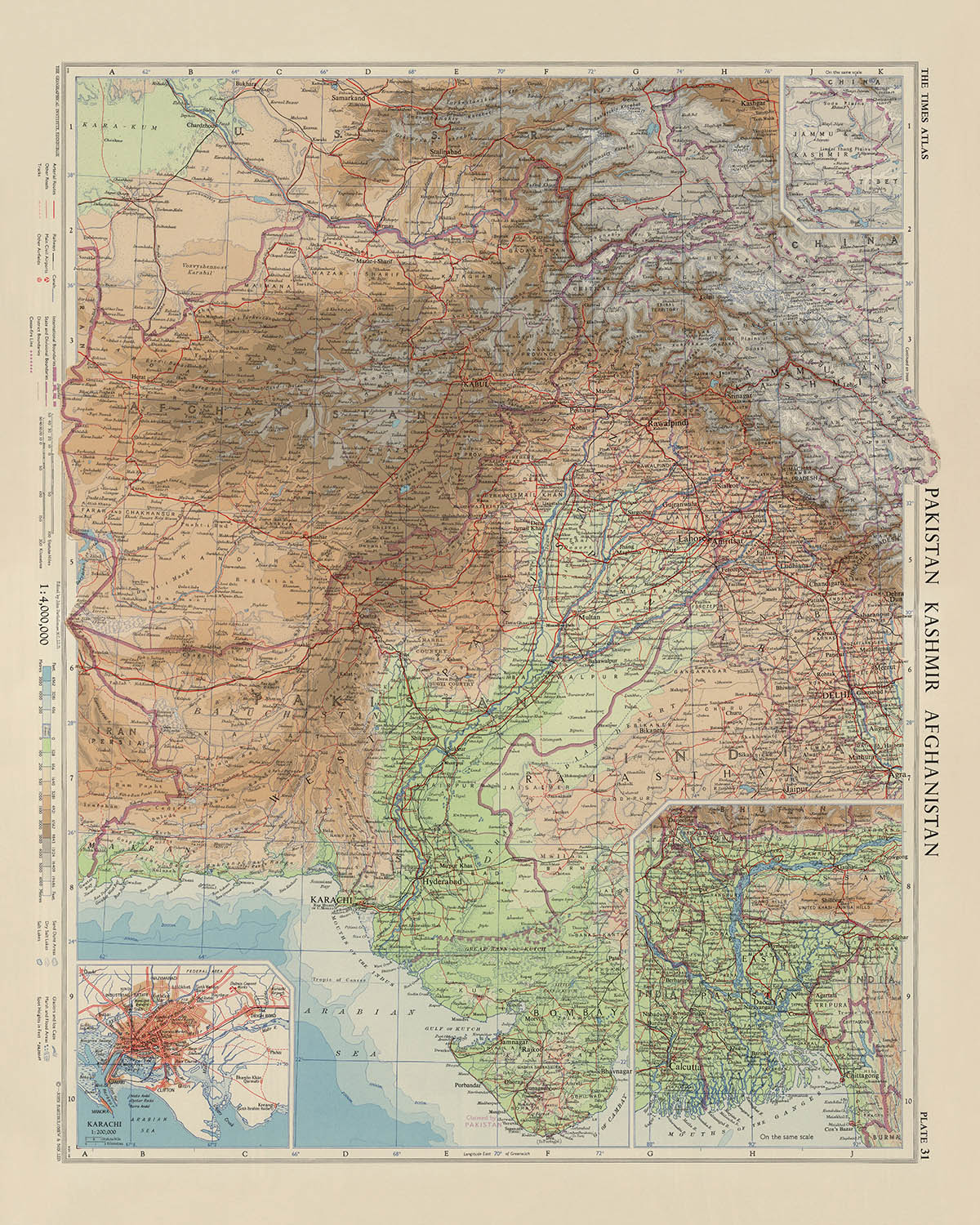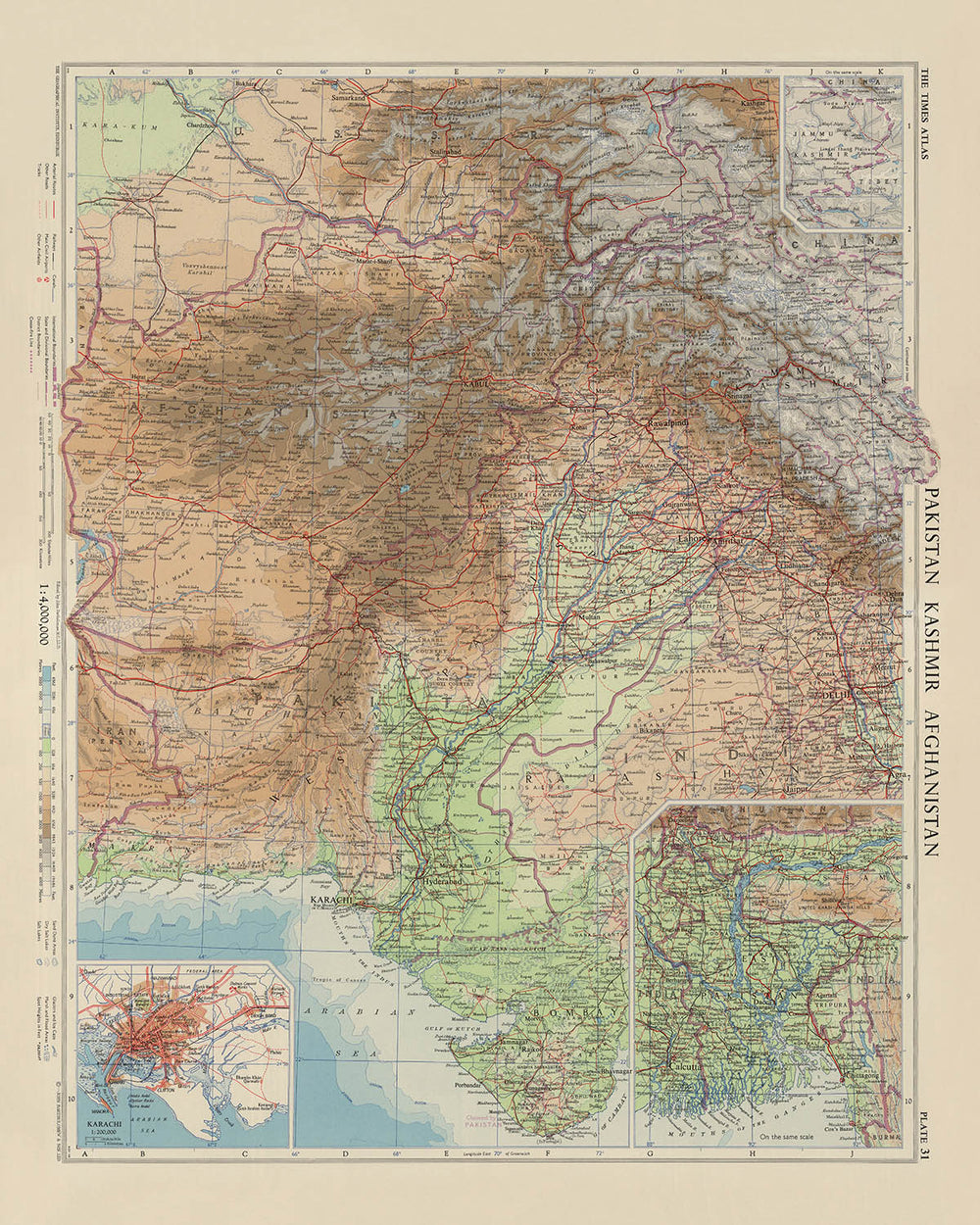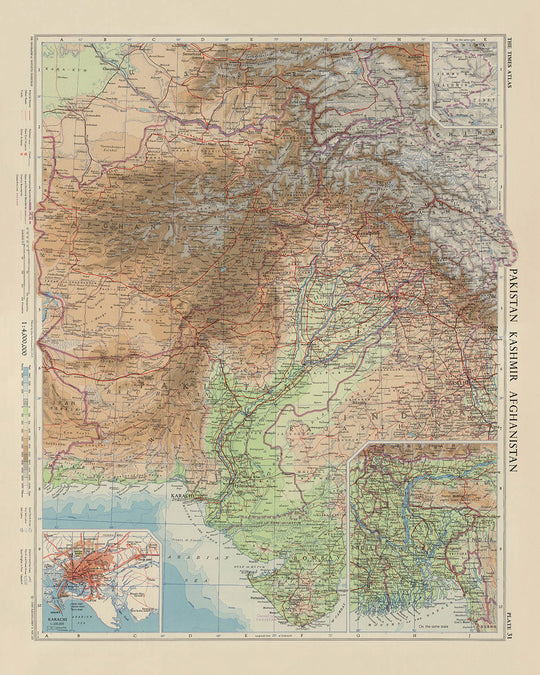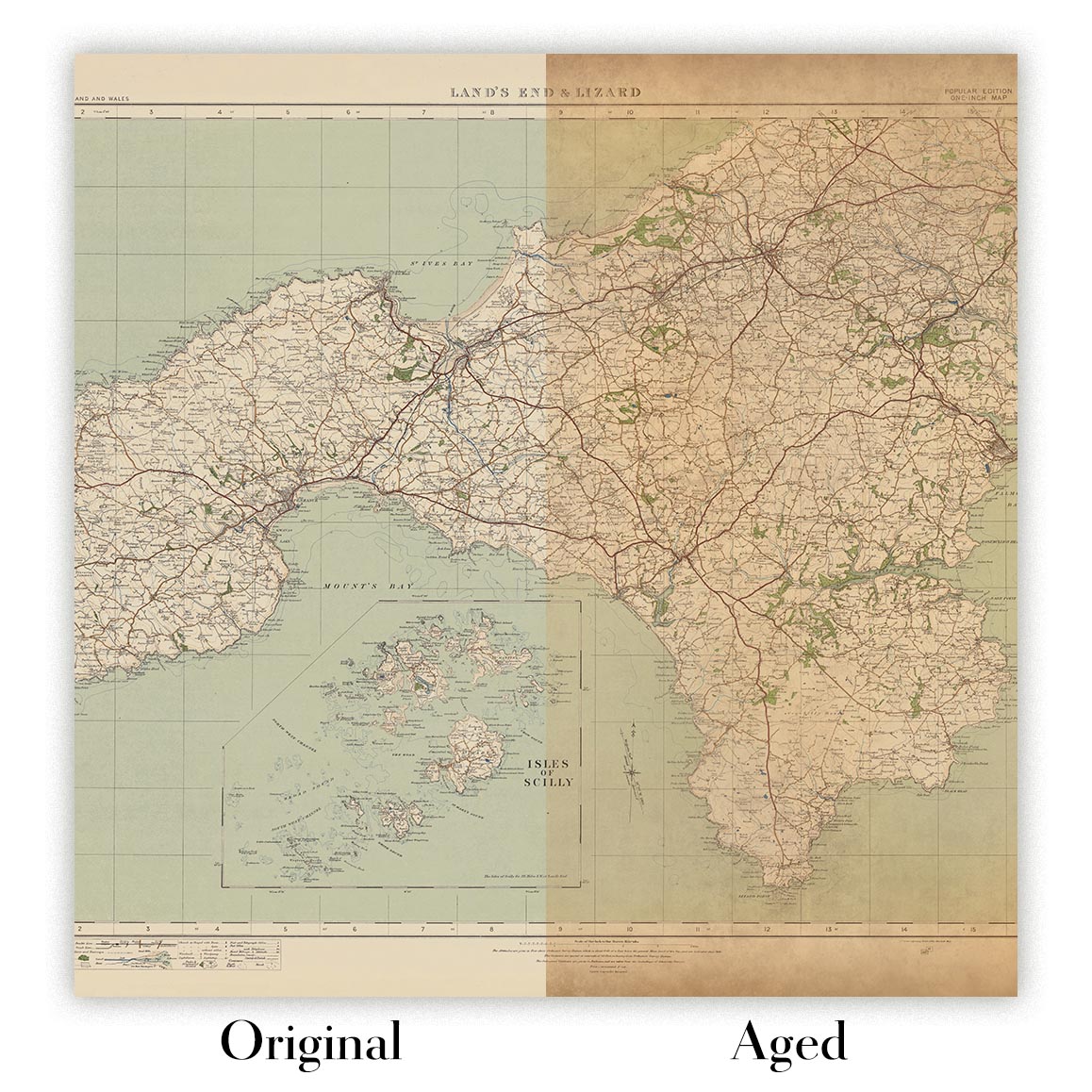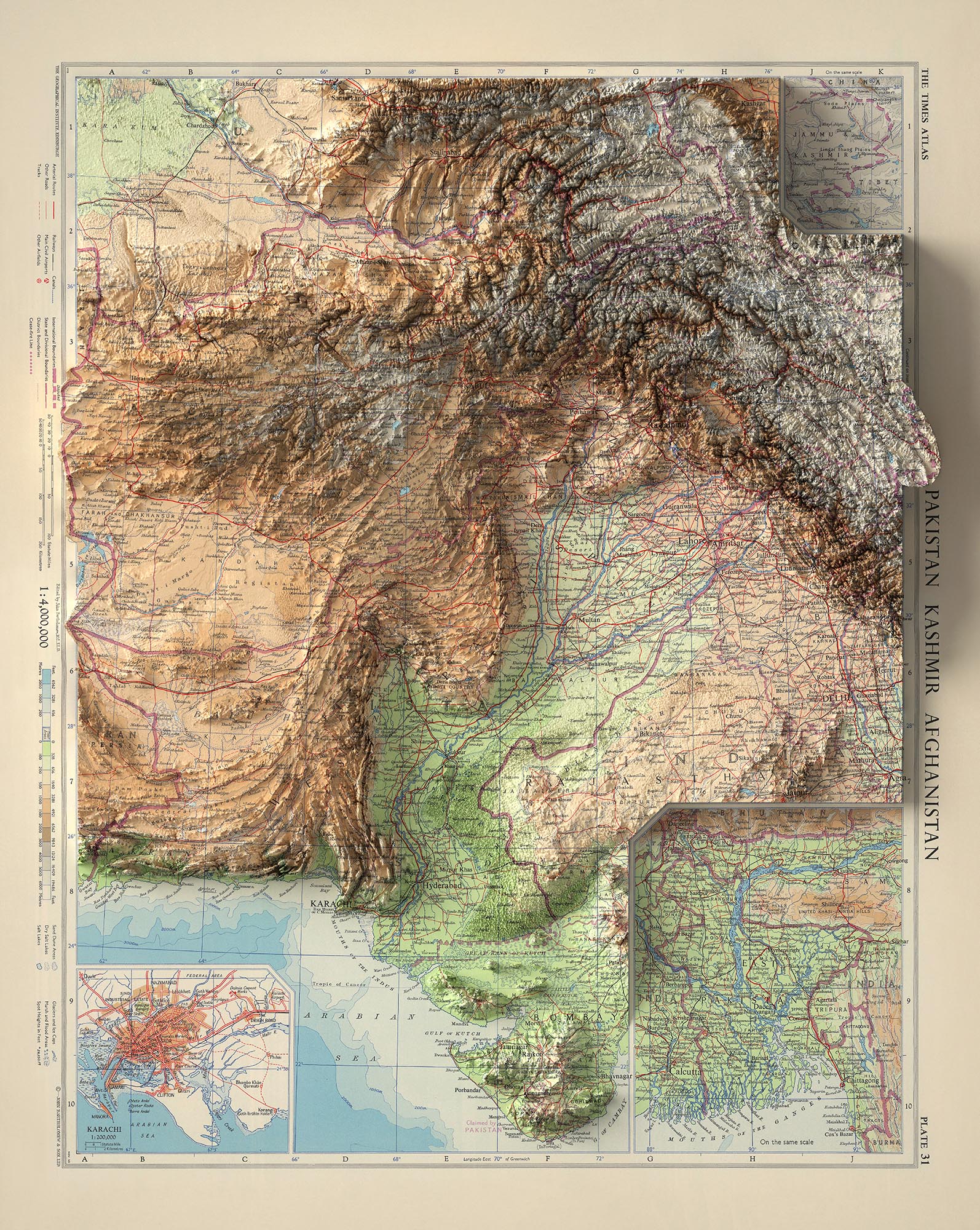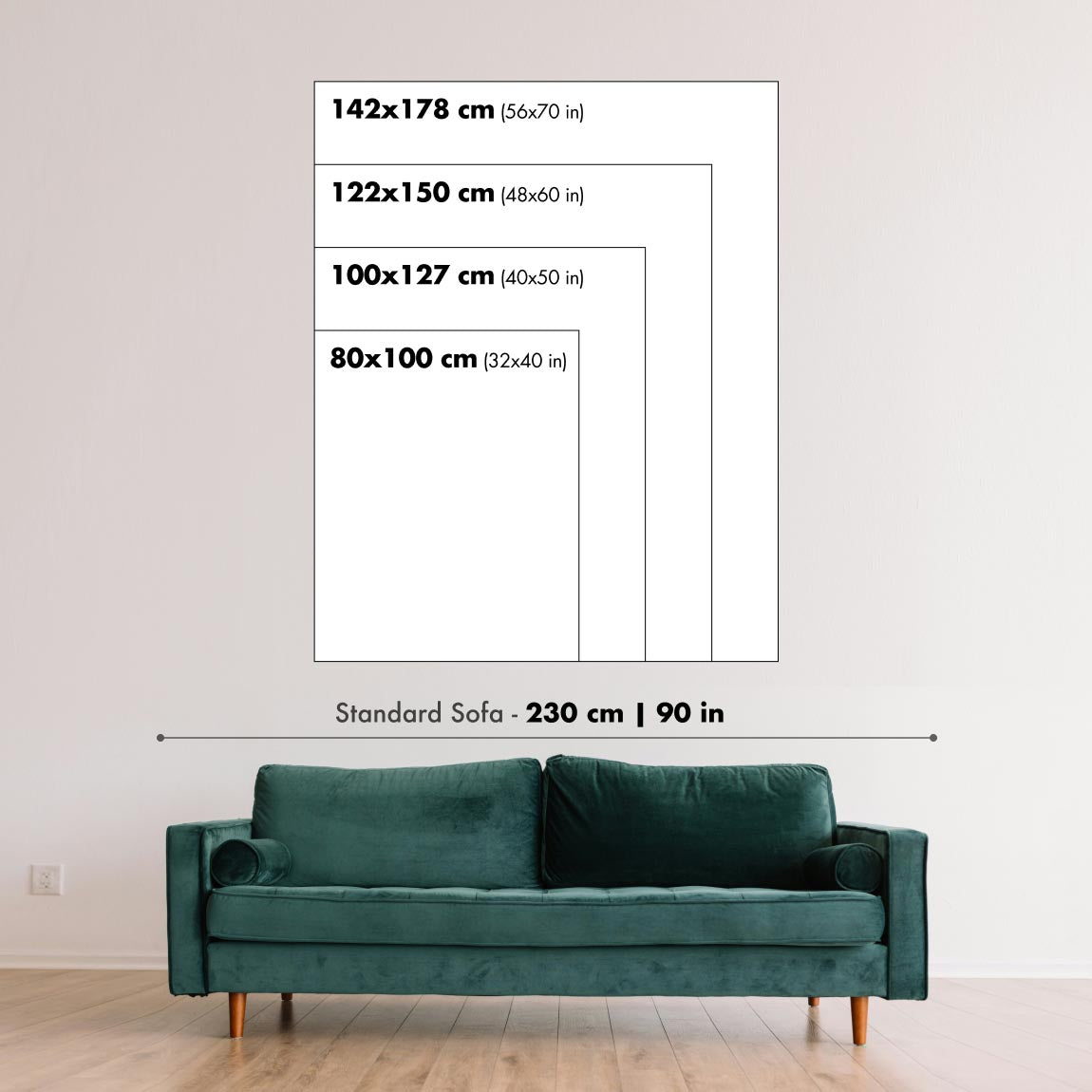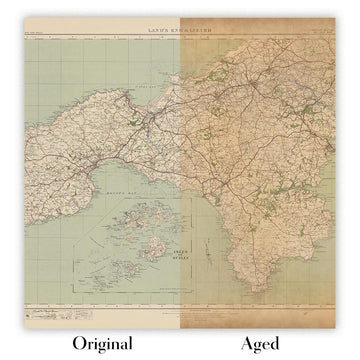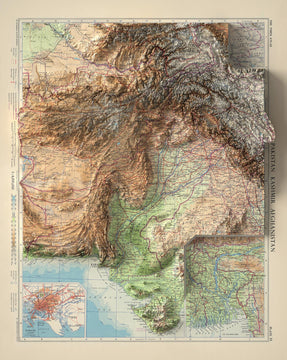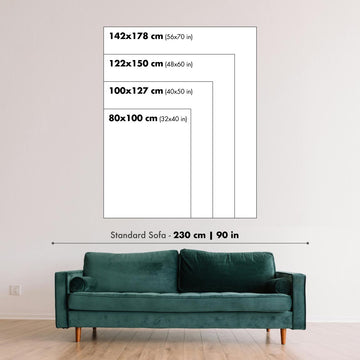- Handmade locally. No import duty or tax
- FREE Delivery by Christmas
- Love it or your money back (90 days)
- Questions? WhatsApp me any time
Own a piece of history
5,000+ 5 star reviews


The "Pakistan, Kashmir, Afghanistan" map, meticulously crafted by the esteemed cartographer JG Bartholomew in 1959, is a masterful representation of the geopolitical and physical landscapes of these regions during a pivotal period in history. Bartholomew, known for his precision and artistry, brings to life the intricate tapestry of South Asia, capturing the essence of its diverse topography and complex political boundaries. This map is not just a navigational tool but a historical document that reflects the post-independence era of Pakistan and the ongoing geopolitical dynamics of the region.
This map is a visual symphony of relief and depth, with gradient tints illustrating the majestic mountains and valleys, and spot heights marking the towering peaks of the Hindu Kush and Karakoram ranges. The rivers, including the mighty Indus and Kabul, weave through the landscape, their courses meticulously charted. The Arabian Sea's gradient depths are depicted with a nuanced palette, providing a sense of the underwater topography that complements the terrestrial features. The map's design is a testament to Bartholomew's expertise in cartographic representation, blending scientific accuracy with aesthetic appeal.
The political boundaries delineated on this map are a reflection of the historical context of the late 1950s. The borders of Pakistan, Afghanistan, and the disputed regions of Kashmir are clearly marked, providing insight into the geopolitical tensions and territorial claims of the time. The provincial boundaries within Pakistan and Afghanistan further illustrate the administrative divisions that were crucial for governance and control. This map serves as a window into the political landscape of South Asia, offering a glimpse into the complexities and challenges faced by these nations.
Cities and towns are prominently featured, with Karachi, Lahore, and Kabul standing out as major urban centers. The map also highlights other significant settlements such as Peshawar, Quetta, and Srinagar, each with its own unique historical and cultural significance. These urban areas are interconnected by a network of railways and major roads, reflecting the infrastructure development and connectivity of the region. The detailed depiction of these human settlements provides a comprehensive view of the population distribution and urbanization patterns of the time.
In addition to its geographical and political significance, this map is a work of art that showcases the cartographic excellence of JG Bartholomew. His ability to combine detailed topographical information with elegant design elements makes this map a valuable addition to any collection. It is not only a tool for understanding the physical and political landscape of Pakistan, Kashmir, and Afghanistan but also a piece of history that captures the essence of a bygone era. This map is a testament to Bartholomew's legacy as one of the foremost cartographers of his time.
Cities and towns on this map
- Pakistan
- Karachi (modern-day population: ~14.9 million)
- Lahore (modern-day population: ~11.1 million)
- Rawalpindi (modern-day population: ~2.1 million)
- Peshawar (modern-day population: ~1.97 million)
- Quetta (modern-day population: ~1.1 million)
- Multan (modern-day population: ~1.87 million)
- Hyderabad (modern-day population: ~1.73 million)
- Faisalabad (modern-day population: ~3.2 million)
- Sialkot (modern-day population: ~0.9 million)
-
Sukkur (modern-day population: ~0.55 million)
-
Afghanistan
- Kabul (modern-day population: ~4.6 million)
- Kandahar (modern-day population: ~0.6 million)
-
Herat (modern-day population: ~0.5 million)
-
Kashmir
- Srinagar (modern-day population: ~1.2 million)
Notable Features & Landmarks
- Inset maps:
- Inset of Karachi and its surroundings.
- Inset of the eastern regions, likely including parts of East Pakistan (now Bangladesh).
- Bodies of water:
- Arabian Sea
- Indus River
- Kabul River
- Various smaller rivers and lakes
- Borders:
- International borders of Pakistan, Afghanistan, and regions of Kashmir.
- Provincial and regional boundaries within Pakistan and Afghanistan.
- Mountains:
- Hindu Kush
- Karakoram Range
- Various other mountain ranges and peaks marked with spot heights.
- Other notable features:
- Railways and major roads.
- Various topographical features such as plains, deserts, and valleys.
Historical and design context
- Full-color map.
- Relief shown by gradient tints and spot heights in feet.
- Depth shown by gradient tints and soundings.
- Prime meridian is Greenwich.
- No. 1721, and Nov. 58, marked on the lower corners of plate.
- "The Times Atlas" marked on the upper left corner.
- When the map was made: 1959
- Mapmaker or publisher: JG Bartholomew
- Context about the mapmaker: JG Bartholomew was a notable Scottish cartographer known for his detailed and accurate maps. He was affiliated with The Times Atlas, a renowned atlas series.
- Topics and themes shown on the map:
- Political boundaries and regions.
- Physical geography, including mountains, rivers, and relief.
- Depth of bodies of water.
- Context about themes: The map provides a detailed view of the geopolitical and physical landscape of the region during the late 1950s, capturing significant historical context such as post-independence borders and regional topography.
- Countries and regions shown on the map:
- Pakistan
- Kashmir
- Afghanistan
- Context about the design or style of the map: The map uses gradient tints to show relief and depth, with spot heights in feet, adhering to the style of mid-20th-century cartography. It includes detailed geographical features and political boundaries.
- Historical significance or context: The map captures a critical period in South Asian history, shortly after the independence of Pakistan in 1947 and amidst ongoing geopolitical tensions in the region.
Please double check the images to make sure that a specific town or place is shown on this map. You can also get in touch and ask us to check the map for you.
This map looks great at every size, but I always recommend going for a larger size if you have space. That way you can easily make out all of the details.
This map looks amazing at sizes all the way up to 70in (180cm). If you are looking for a larger map, please get in touch.
Please note: the labels on this map are hard to read if you order a map that is 40in (100cm) or smaller. The map is still very attractive, but if you would like to read the map easily, please buy a larger size.
The model in the listing images is holding the 16x20in (40x50cm) version of this map.
The fifth listing image shows an example of my map personalisation service.
If you’re looking for something slightly different, check out my collection of the best old maps to see if something else catches your eye.
Please contact me to check if a certain location, landmark or feature is shown on this map.
This would make a wonderful birthday, Christmas, Father's Day, work leaving, anniversary or housewarming gift for someone from the areas covered by this map.
This map is available as a giclée print on acid free archival matte paper, or you can buy it framed. The frame is a nice, simple black frame that suits most aesthetics. Please get in touch if you'd like a different frame colour or material. My frames are glazed with super-clear museum-grade acrylic (perspex/acrylite), which is significantly less reflective than glass, safer, and will always arrive in perfect condition.
This map is also available as a float framed canvas, sometimes known as a shadow gap framed canvas or canvas floater. The map is printed on artist's cotton canvas and then stretched over a handmade box frame. We then "float" the canvas inside a wooden frame, which is available in a range of colours (black, dark brown, oak, antique gold and white). This is a wonderful way to present a map without glazing in front. See some examples of float framed canvas maps and explore the differences between my different finishes.
For something truly unique, this map is also available in "Unique 3D", our trademarked process that dramatically transforms the map so that it has a wonderful sense of depth. We combine the original map with detailed topography and elevation data, so that mountains and the terrain really "pop". For more info and examples of 3D maps, check my Unique 3D page.
For most orders, delivery time is about 3 working days. Personalised and customised products take longer, as I have to do the personalisation and send it to you for approval, which usually takes 1 or 2 days.
Please note that very large framed orders usually take longer to make and deliver.
If you need your order to arrive by a certain date, please contact me before you order so that we can find the best way of making sure you get your order in time.
I print and frame maps and artwork in 23 countries around the world. This means your order will be made locally, which cuts down on delivery time and ensures that it won't be damaged during delivery. You'll never pay customs or import duty, and we'll put less CO2 into the air.
All of my maps and art prints are well packaged and sent in a rugged tube if unframed, or surrounded by foam if framed.
I try to send out all orders within 1 or 2 days of receiving your order, though some products (like face masks, mugs and tote bags) can take longer to make.
If you select Express Delivery at checkout your order we will prioritise your order and send it out by 1-day courier (Fedex, DHL, UPS, Parcelforce).
Next Day delivery is also available in some countries (US, UK, Singapore, UAE) but please try to order early in the day so that we can get it sent out on time.
My standard frame is a gallery style black ash hardwood frame. It is simple and quite modern looking. My standard frame is around 20mm (0.8in) wide.
I use super-clear acrylic (perspex/acrylite) for the frame glass. It's lighter and safer than glass - and it looks better, as the reflectivity is lower.
Six standard frame colours are available for free (black, dark brown, dark grey, oak, white and antique gold). Custom framing and mounting/matting is available if you're looking for something else.
Most maps, art and illustrations are also available as a framed canvas. We use matte (not shiny) cotton canvas, stretch it over a sustainably sourced box wood frame, and then 'float' the piece within a wood frame. The end result is quite beautiful, and there's no glazing to get in the way.
All frames are provided "ready to hang", with either a string or brackets on the back. Very large frames will have heavy duty hanging plates and/or a mounting baton. If you have any questions, please get in touch.
See some examples of my framed maps and framed canvas maps.
Alternatively, I can also supply old maps and artwork on canvas, foam board, cotton rag and other materials.
If you want to frame your map or artwork yourself, please read my size guide first.
My maps are extremely high quality reproductions of original maps.
I source original, rare maps from libraries, auction houses and private collections around the world, restore them at my London workshop, and then use specialist giclée inks and printers to create beautiful maps that look even better than the original.
My maps are printed on acid-free archival matte (not glossy) paper that feels very high quality and almost like card. In technical terms the paper weight/thickness is 10mil/200gsm. It's perfect for framing.
I print with Epson ultrachrome giclée UV fade resistant pigment inks - some of the best inks you can find.
I can also make maps on canvas, cotton rag and other exotic materials.
Learn more about The Unique Maps Co.
Map personalisation
If you're looking for the perfect anniversary or housewarming gift, I can personalise your map to make it truly unique. For example, I can add a short message, or highlight an important location, or add your family's coat of arms.
The options are almost infinite. Please see my map personalisation page for some wonderful examples of what's possible.
To order a personalised map, select "personalise your map" before adding it to your basket.
Get in touch if you're looking for more complex customisations and personalisations.
Map ageing
I have been asked hundreds of times over the years by customers if they could buy a map that looks even older.
Well, now you can, by selecting Aged before you add a map to your basket.
All the product photos you see on this page show the map in its Original form. This is what the map looks like today.
If you select Aged, I will age your map by hand, using a special and unique process developed through years of studying old maps, talking to researchers to understand the chemistry of aging paper, and of course... lots of practice!
If you're unsure, stick to the Original colour of the map. If you want something a bit darker and older looking, go for Aged.
If you are not happy with your order for any reason, contact me and I'll get it fixed ASAP, free of charge. Please see my returns and refund policy for more information.
I am very confident you will like your restored map or art print. I have been doing this since 1984. I'm a 5-star Etsy seller. I have sold tens of thousands of maps and art prints and have over 5,000 real 5-star reviews. My work has been featured in interior design magazines, on the BBC, and on the walls of dozens of 5-star hotels.
I use a unique process to restore maps and artwork that is massively time consuming and labour intensive. Hunting down the original maps and illustrations can take months. I use state of the art and eye-wateringly expensive technology to scan and restore them. As a result, I guarantee my maps and art prints are a cut above the rest. I stand by my products and will always make sure you're 100% happy with what you receive.
Almost all of my maps and art prints look amazing at large sizes (200cm, 6.5ft+) and I can frame and deliver them to you as well, via special oversized courier. Contact me to discuss your specific needs.
Or try searching for something!







